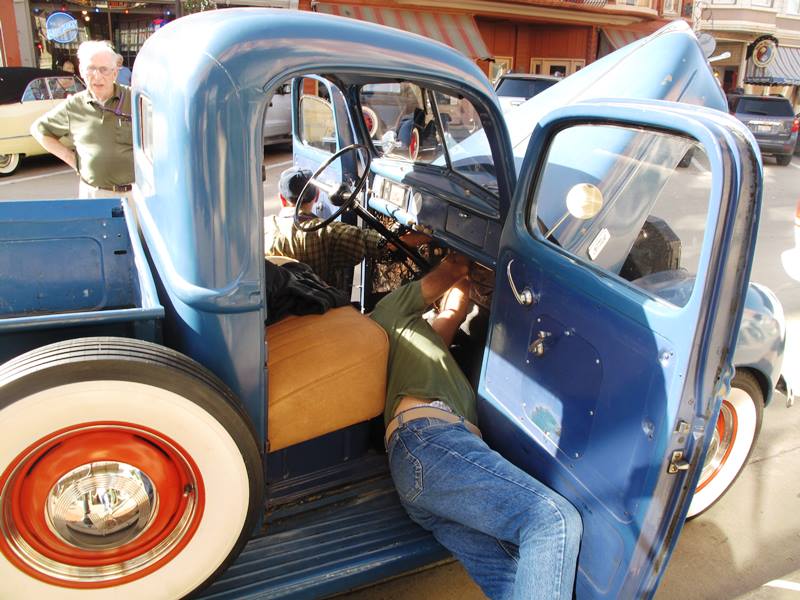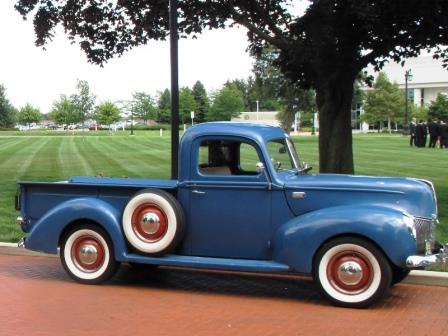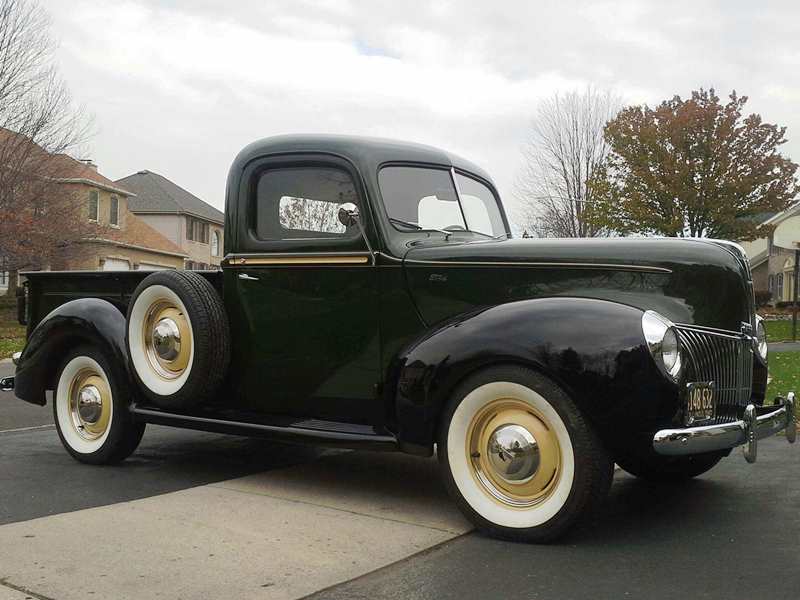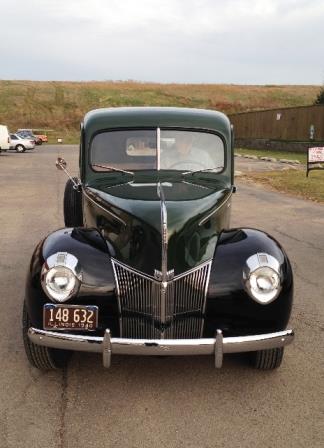My 1940 Ford Pickup Story
By Ron Steck
Here is a little story of how I came about getting and restoring my 1940 Ford
Pickup. I was retiring in 2011 and
was looking to do a Pickup project.
I had been looking at different web sites and one day I was on eBay.
I had been looking at 46-47 Ford pickups and then took a liking to the
40-41 pickups. Well, in April of
2010 there was a 1940 out in Rockford, IL and I was able to take a ride out to
look at it. Seeing it for the first
time and not knowing what all to look for was a little confusing.
I took it for a drive and was surprised how much different an old truck
drove.
My first car was a 55 Ford a long time ago but kind of the same feeling.
The body was in decent shape, no big rust issues or big dents.
The truck had been owned by a man in Rockford for 5 years and he had
never gotten around to do a restoration on it and wanted to sell it.
I bought the truck about a week later and to my surprise the title he had
was from Oregon; great news - they don't use salt on their highways.
After getting the truck home I started to do some work on it.

Here is a good tip if youíre going to do a car or a truck: learn about where you
want to go with the restoration.
Saves $$$$ and time. I jumped in
and started to do some restoration work: wire brushing the frame, painting
different areas, changing some parts and then finding out more info on the
truck. I found I had a 1950 Mercury
engine, still a flathead, which I had rebuilt, along with a Columbia two-speed
rear end that was not working but drivable.
By the fall of 2011 there was too much noise in the rear end and it was
time for a rebuild - again $$$$. I
found John Connelly in California who rebuilds Columbias.
He put me in contact with Scott Gilday who had a Columbia and knew how to
put them back together. Talking
with Scott he had asked me if I had heard of the Early Ford V-8 Club and I had
not. Again, research.
I went to one of their meetings and joined the next month.
These car clubs are a deep well of knowledge and one should join if you
don't have all the knowledge of doing these vehicles.
My father and brother were car mechanics and I had picked up some things from them in my younger years; having older cars some time ago, you have to go back in the memory banks. Summer of 2012 - by now new tires, new exhaust system, new rear end and all associated parts, more new parts, rebuilt starter, generator, distributor. Again $$$$. I drove the pickup to car shows and took a trip up the Mississippi River with the car club. In Galena the truck breaks down. Make a call, get some advice to change the coil with the spare that you brought with you and youíre back on the road again. We don't have a computer that you have to plug into to find out what is wrong. Thatís the wealth of knowledge.

This club that I belong to has been around for 50 years and includes 1932 -1953
cars and trucks with the flathead engines as its mainstay.
Into the winter of 2012 and the throw out bearing is making noise; drop
the rear end again. NOTE TO SELF:
when having the engine or the rear end rebuilt, redo the clutch assembly at the
same time. Thatís the time thing
and some $$$. Smarter now, I had
known a man who was a transmission mechanic when I was young and he was a friend
of my parents. What are the chances
of running into him at a car show after not seeing him for 34 years?
He helped me rebuild the transmission.
Here we go putting the clutch and transmission in, little problem with a
scrape, a little filing and weíre good to go.
Put the rear end back in with all new brake lines.
Oh, by the way, when I got the truck I checked the brakes somewhat, found
out later only 2 of the 8 shoes were working - found out when a vehicle has sat
that long the wheel cylinders were shot and rusted so they were not pushing out
the shoes to slow down. Now weíre
talking a new drive train from the engine to the rear end, new tires, bearings,
other parts - $$$.

Now it is spring of 2013; Iíve been retired for almost 2 years and had the time
to learn and do a lot of work on the truck.
Time for more car shows and a trip with the club to Dearborn, MI.
You haven't lived until you take a 6í-2" man and put him in a 1940 Ford
Pickup doing 62 MPH for a couple of hours.
Reminded me of when I was in the Army flying helicopters that we could go
for 2 hours and then had to refuel; it was good to get out and stretch.
I have a 2011 F150 and it sure is a pleasure to drive, more room and
bigger cab too. Now the fall of
2013 and here we go starting the final restoration.
The guys who are doing the metal work and the painting have been chosen.

I started to take the truck apart - that all happened in about 4 days.
Take pictures of everything as it will save you time in putting things
back, but remember those parts can only go in one place.
Now is when you start to see all the parts you should replace knowing you
don't want to take them apart again.
I wasn't going to take the cab off to be media blasted like the fenders
and bed but I was told it would be a better job.
So we took the cab off and had it blasted.
Also, funny thing I could put the cab in the bed of my F150 with no
problem. When I got it back I knew
the floors had been patched but was not going to have them redone.
One of the guys in the club gave me the company that makes new panels and
so I got new ones along with running boards.
Hereís the thing I said earlier, know where you are going with your
restoration. I canít say that
enough. I was lucky in the fact
that I had great people to work with on mine and so I was walked through the
steps we were to take.
Sometimes it is less costly to buy a new part than to fix the old; labor costs
will eat you up. As we went along a
little rust in the cab corners was an easy fix.
Along with the new floor panels, the roof had a lot of little dents that
were hammered out along with a couple of dings in the fenders.
Remember this is a 74 year old truck with a lot of history, most likely
from a farm, so it was a work truck.
I took the frame home to do clean up and touch up and thought I was doing
a good job. Once you see the work
these guys were doing to the other parts of the body you start to see what
youíre giving them back and it's not the same quality - you need to ask for help
and I received it. You can't have a
great looking top and the undercarriage is not the same.
So I took off that rear end again; one of the guys in the club had an
engine puller, out it came, and then the front end was removed.
I had never gone this far with doing this kind of work so it was all new to me.
The frame was blasted - good thing because it had some cracks.
Weak spots were fixed and it was off to be powder coated.
In January 2014 it was time to start putting the frame and drive train
back together with all new parts.
Thatís the $$$$ part of it. Now,
with the front end off, I could install all new rubber parts, shocks, king pin
bushings, drag links, and rebuild the steering box.
This is the time to do it correctly as it is much easier now than later.
This is now a good looking under carriage.
With the body work continuing the frame waits to be mated up once again.
The paint was picked and come May the cab is painted - we now see that it was
worth all that extra work. The
chassis is brought back, the cab is mounted, and work begins to start
reassembly. Next the bed, then the
doors, fenders, running boards, hood, and all new hardware to bolt it all
together. Thatís where the research
comes in on all of these things.
Then there you are one day and itís time to start it up for the first time.
It didnít. Now you start to
search for why not and call on some of your knowledge or rely on others with a
lot more to come to the rescue. My
friend Frank helped by getting the timing corrected - then you hit the starter
button and life starts again in that 64 year old engine with the looks of a new
truck.

Now it is 2015 and this truck is 75 years old.
Itís been a lot of fun (and sometimes not), but the end result is in the
eye of the beholder. I cannot
stress enough to know where you are going with doing one of these projects; it
is not cheap by any means, even if you can do it all.
My many thanks to Frank who I met at a car show, who helped early on with
my wiring and more recently getting the truck started again.
He had introduced me to Fred who did the metal work and body work and
assembly. Also to Mike who owns the
shop where the truck was painted for his great painting and body work.
I consider these friends now and was lucky to have met them.
I also want to thank Scott, John, Lloyd, Joe, Tom, Ken who are members of
the Northern Illinois Regional Group for their assistance in helping me with
this project.

